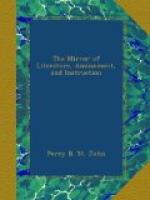* * * * *
THE SELECTOR;
AND
LITERARY NOTICES OF
NEW WORKS.
* * * * *
SAILING ROUND CONSTANTINOPLE.
Hiring a peramidias, or one of the beautiful boats which ply on the canal, I proceeded, accompanied by my janissary and dragoman, to make the circuit of the city, by rowing round the Seraglio Point into the sea of Marmora, then landing at the Seven Towers, and walking across the isthmus by the famous wall to the Golden Horn, where we again embarked, and returned to Pera. On passing the Seraglio Point, we remarked a number of cannon of different forms, ranged apparently more for effect than defence, as a sloop of war with a commanding breeze might dislodge the men; such is their exposed situation. Although two of the guns appeared to be of the calibre of sixteen or seventeen inches, and calculated to throw some immense stone-balls, which we observed near them, others were of small calibre, but having twelve barrels; over them, were suspended some very large bones, about which I could not get even a marvellous account, both my companions declaring honestly their ignorance of their history. The current sent us, with astonishing rapidity, round the Point, (on which men are always stationed with small lines to track boats upwards,) and we soon landed under the Seven Towers. The town on the west side, towards the sea presents a poor and miserable appearance. We were allowed just to enter the outer court of the castle, as it may be more properly called than the Seven Towers, because there are only two conspicuous towers, and I suspect that the term Seven Towers was originally applied to the whole wall which runs across the isthmus, and which has seven gates, over each of which was formerly placed a tower.
Leaving the castle, we proceeded along the great road which runs parallel to the venerable and highly interesting triple walls, said to have been begun by Constantine, and enlarged by the second Theodosius. They consist of alternate courses of large flat bricks and stones, in some parts perfect, with their battlements and towers; in others partly destroyed by earthquakes or time—the whole rendered venerable by thick ivy or shading trees. The height of the walls is such, that, when near them, the town is completely hid; and as the ditches are well cultivated as gardens or orchards, and the country beyond is clear of houses, it is difficult to fancy one’s self so near the thickly populated city, once the mistress of the eastern world. The distance across the isthmus to the Golden Horn, or harbour, is about four miles, and the walls are uninterrupted by the before-mentioned gates. At about two-thirds of the distance, we came to Baloucli, where, in the ruins of a chapel dedicated by Justinian to the Virgin, is a fountain or well of excellent cold water, said to contain fish, black on one side and red on the other, or, according to tradition, half fried.




